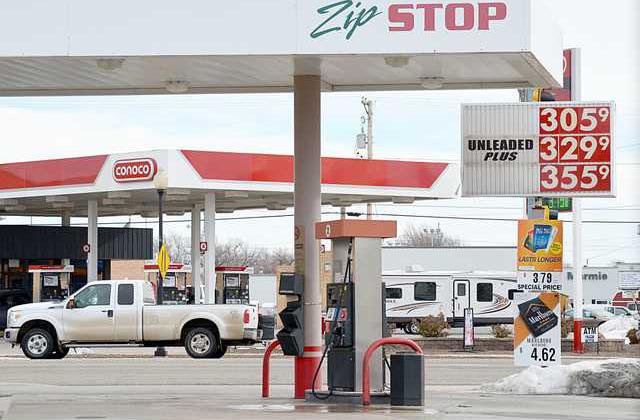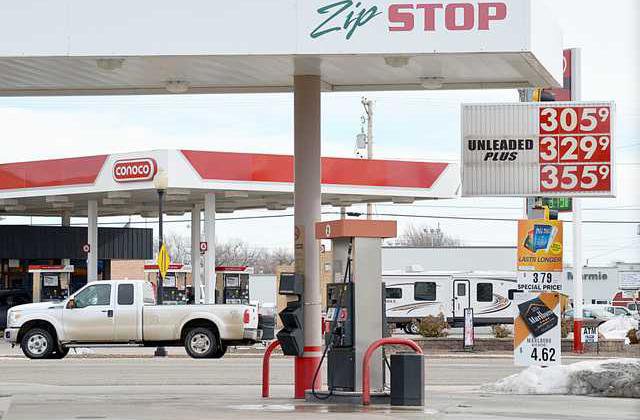Average retail gasoline prices in Kansas have risen 9.3 cents per gallon in the past week, averaging $3.09 Sunday, according to GasBuddy’s daily survey of 1,329 gas outlets in Kansas. This compares with the national average that has increased 4.9 cents in the last week to $3.29.
Including the change in gas prices in Kansas during the past week, prices yesterday were 1.2 cents per gallon higher than the same day one year ago and are 10.3 cents per gallon higher than a month ago. The national average has increased 4.0 cents per gallon during the last month and stands 2.2 cents per gallon higher than this day one year ago.
The lowest price, $2.95, was reported at Girard, Pittsburg and Emporia. The highest price, $3.39, was reported just of I-35 at McPherson.
Great Bend came in near the average at $3.05. Around the area, $3.05 was reported at Larned, $3.09 at Lyons and $3.19 at Russell.
“The sub $3 per gallon gas was great while it lasted, but unfortunately it has nearly completely dried up,” said GasBuddy.com senior petroleum analyst Patrick DeHaan. “As of late Sunday night, zero states were seeing their averages under $3 per gallon.”
As the New Year rolls in, this is a type of trend that DeHaan and other analysts are used to seeing. “The bottom is behind us and prices generally begin the New Year on a higher note, like they will again this year.”
But, the trend won’t last forever though, as January and February feature generally weak demand that should limit increases and keep prices relatively moderate for the next month or two, DeHaan said.
What’s ahead?
Looking to the future, DeHaan said U.S. gasoline prices will indeed see huge swings and regional volatility in 2014, but GasBuddy analysis suggests that when all the final figures are calculated, the average price next year will fall by about 10 cents per gallon gal from 2013 numbers.
That would push the yearlong average below $3.40 gal for the first time since 2010 when motor fuel averaged $2.78 gal for the year. “The usual upside risks will still be present (U.S. refinery maintenance, storm threats, disruption in the Middle East and North Africa) but 2014 projects to be a year that will find more consistent downward pressure on U.S. prices than in any year since the Great Recession,” he said.
It was not uncommon to find a dollars’ worth of difference between street prices in different states throughout all of 2013, and that state-by-state diversity will continue and even broaden in 2014, he said. Many of the differences are attributable to tax treatment, but incredibly variable crude costs and wholesale gasoline prices accentuate the diversity.
Hawaii stands alone as the single U.S. state that moves according to specific global metrics, and it is the only state where GasBuddy projects a $4 gal or higher 2014 average. Fourteen states spent some time with statewide averages above $4 gal at some point in 2013, but we suspect that such moves will be rare or extraordinary in 2014.
Seventeen state averages bottomed out below $3 gal in 2013, and we suspect that such trips to low latitude will be a much more regular occurrence next year. Note: Two states (Minnesota and Nebraska) had the unusual distinction in 2013 of achieving averages above $4 gal and below $3 gal.
“While 2014 should deliver a more temperate gasoline price background than 2011, 2012, and 2013, we see the potential for dramatic price spikes and equally dramatic price plunges,” DeHaan said. California, for example, will spend some time near the end of the first quarter above $4. Illinois, and to a lesser extent some of the adjacent Great Lakes’ states, could face a price spike tied to refinery issues that would bring some of the metropolitan areas some 50-75 cents per gallon above year-end 2013 numbers.
But the interior of the country (a beneficiary of the most discounted crude oil on the planet) should largely have the greatest insulation against super-spikes. Motorists traveling in the Great Lakes, Great Plains, and Rocky Mountain states are among those most likely to see pricing points not documented since 2010.
The likelihood of a late first quarter 2014 rally in prices from winter lows remains quite high, GasBuddy reports. Factors that contribute to a seasonal gasoline rally haven’t changed.
February through April tends to see plenty of refinery maintenance ahead of the so-called driving season. Specifications for gasoline change in the second calendar quarter and cheaper components that are plentiful in the winter can’t be used during the warmer weather months.
The final numbers for U.S. gasoline consumption won’t be delivered by the Energy Information Administration until February, but 2013 may indeed have seen a small rise in demand, which would be the first annual increase since the peak demand year of 2007. For perspective, gasoline demand averaged 390-million gallons per day in 2007, compared to 365-million gallons in 2012.
However, a major increase in consumption is improbable in 2014. Demand faces considerable headwinds. U.S. drivers are aging and the fastest growing demographic group includes those over the age of 55, and represents people who will drive less and less. Tougher CAFÉ standards are also ingrained within vehicle requirements, particularly from 2016 forward.
It is clear that 2014 will continue to see gasoline reign as king of the transportation fuels, DeHaan said. But watch for diesel to make some more inroads in mid-decade years. Research confirms as many as 40 new light-duty diesel-fueled vehicles will be introduced between now and the end of 2015. Despite higher street prices, diesel could see its market share of light duty vehicles increase to 3 percent or 4 percent in relatively short order.
ON THEIR WAY UP
2013 highlighted by some of the lowest gas prices in years





